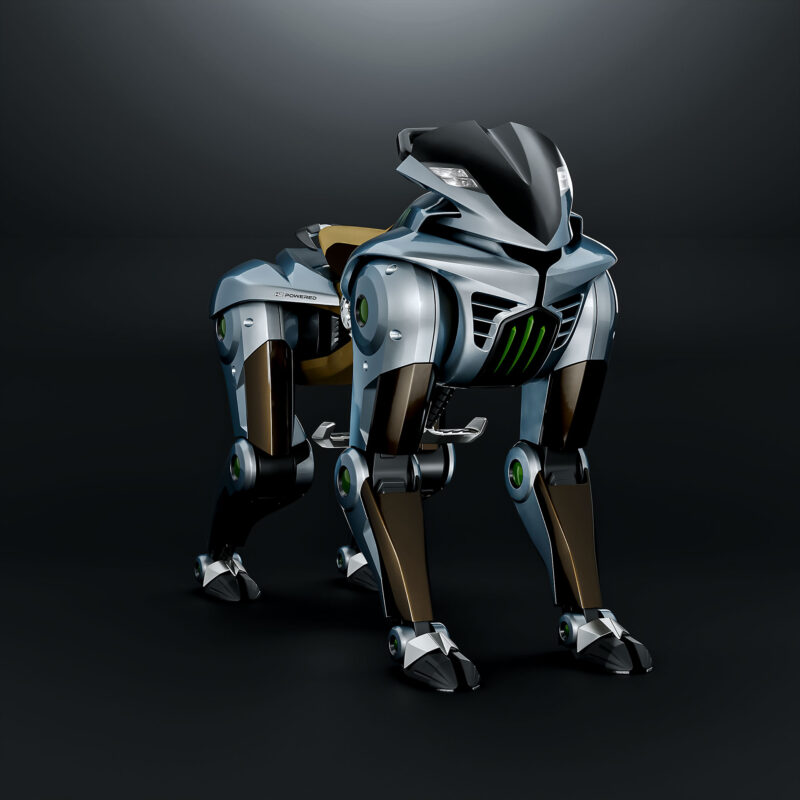In an era where technological advancements are rapidly reshaping our world, Kawasaki’s unveiling of the CORLEO—a hydrogen-powered, rideable quadruped robot—marks a significant milestone. This article delves into the intricacies of CORLEO, exploring its design, functionality, and the broader implications it holds for the future of mobility and sustainable innovation.
- The Birth of CORLEO: A Fusion of Nature and Technology
Kawasaki Heavy Industries introduced CORLEO at the Osaka-Kansai Expo 2025, presenting a visionary concept that marries the grace of a lion with cutting-edge robotics. The name “CORLEO” draws inspiration from “Cor Leonis,” the brightest star in the Leo constellation, symbolizing strength and leadership.
• Design Inspiration: CORLEO’s structure emulates the skeletal framework of a lion, aiming for agility and stability across diverse terrains.
• Hydrogen-Powered Engine: Equipped with a 150cc hydrogen engine, CORLEO generates electricity to power its leg-mounted drive units, ensuring low emissions and silent operation.
• Intuitive Control System: Riders steer CORLEO through body movements—leaning forward prompts movement ahead, while shifting weight to the side adjusts its direction.
- Engineering Marvel: The Mechanics Behind CORLEO
CORLEO’s design showcases a harmonious blend of mechanical engineering and biomimicry, aiming to replicate the natural movement of quadrupeds.
• Quadrupedal Locomotion: Each of CORLEO’s four legs operates independently, allowing it to navigate uneven terrains like rocks, grass, and steep inclines.
• Adaptive Hooves: The robot’s feet are equipped with slip-resistant rubber hooves, split left-to-right to conform to varied surfaces, enhancing grip and stability. 
• Suspension System: Swing arms in the legs absorb impact, enabling CORLEO to maintain balance and stability even when ascending steep slopes or climbing steps. 
- Human-Machine Synergy: Riding Experience and Interface
CORLEO is designed to offer an immersive riding experience, fostering a deep connection between the rider and the machine.
• Sensor Integration: Sensors embedded in the stirrups and handlebars detect the rider’s movements, allowing for responsive and intuitive control.
• Adjustable Ergonomics: The height of the stirrups can be adjusted to maintain an ergonomic posture, enhancing comfort during rides.
• Navigation Panel: An onboard display provides real-time information on hydrogen levels, rider’s center of gravity, and projected illuminated markers for nighttime rides.
- Environmental Impact: A Step Towards Sustainable Mobility
CORLEO exemplifies Kawasaki’s commitment to sustainable innovation, utilizing hydrogen fuel to minimize environmental impact.
• Zero Emissions: The hydrogen engine emits only water vapor, aligning with global efforts to reduce carbon footprints.
• Silent Operation: The electric motors powered by the hydrogen engine ensure a quiet ride, reducing noise pollution in natural environments. 
• Future Mobility Vision: Kawasaki envisions CORLEO as a potential solution for off-road transportation in the future, aiming for a market launch around 2050. 
- Challenges and Considerations: Navigating the Path Ahead
While CORLEO presents a promising vision, several challenges must be addressed to transition from concept to reality.
• Prototype Limitations: Currently, CORLEO remains a concept vehicle, with no functional prototype available for public testing. 
• Hydrogen Infrastructure: The widespread adoption of hydrogen-powered vehicles depends on the development of a robust hydrogen refueling infrastructure.
• Cost and Accessibility: Ensuring that such advanced mobility solutions are affordable and accessible to the general public remains a significant hurdle.

All Photo credit Kawasaki Heavy Industries [khi.co.jp]
Research Insights and Future Directions
• Integration of AI: Future iterations of CORLEO may incorporate advanced artificial intelligence to enhance navigation and adaptability.
• Material Innovations: Utilizing lightweight and durable materials could improve efficiency and performance.
• Collaborative Development: Partnerships with research institutions and technology companies may accelerate the refinement and deployment of such robotic mobility solutions.
Reflective Questions
1. How can hydrogen-powered robotics reshape personal transportation in the coming decades?
2. What are the potential applications of rideable robots like CORLEO beyond recreational use?
3. How can designers ensure safety and reliability in autonomous or semi-autonomous robotic vehicles?
4. What infrastructure developments are necessary to support the adoption of hydrogen-powered vehicles?
5. How might the integration of AI enhance the functionality and user experience of robotic mobility platforms?
6. What ethical considerations arise with the deployment of advanced robotic transportation systems?
7. How can such innovations be made accessible to diverse populations, including those in remote or underserved areas?
8. What role do public exhibitions like the Osaka-Kansai Expo play in advancing technological innovation?
9. How can collaborations between
